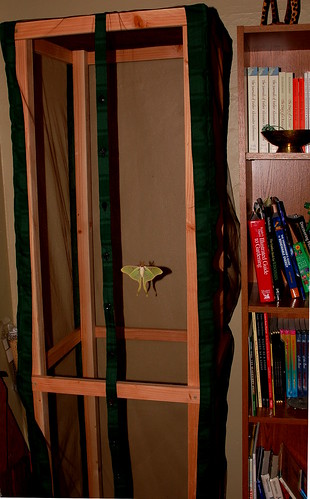Yesterday was an exciting day at the Blue Bungalow Microfarm. We gained two female moths, witnessed the slow death of one, watched a mating dance begin.
It all started around noon. We were preparing to have our lunch when my 4-year-old pointed out that one of our three uneclosed moths was emerging from its cocoon. We were able to watch as the whole process occurred, this one much faster than the first two moths. #3 had a smooth entry into the adult world, coming out in just a minute or two.
I knew right away that it was a female because of her antennae -- they were longer and thinner than the bushy antennae of the males. As she pumped her wings with life, I also observed that she had a bulge in her abdomen the males didn't have. And I noticed that the female seemed more mellow -- she came out and crawled slowly up the screening until she reached the top of the terrarium, where she sat about six inches from the male (#2). When #1 came out, he was a little machine, charging around everywhere even when his wings were tiny stubs. #2 had that leg-loss trauma but was still more active than #3.
Later that afternoon I walked into my office and gasped when I saw that another moth had eclosed without us knowing. She was sitting on the terrarium screening pumping her wings. I could not believe I finally had a mix of males (well, one male, really -- #1 was barely alive) and TWO females. That meant mating would proceed promptly, right? When I raised
Silkworm Moths last year, they emerged from their cocoons and were mating like fiends before their wings were full.
Not so with the Lunas. The three beautiful adult moths sat at the top of the aquarium for *hours* without moving even slightly.
Finally, around 8:30 p.m., some action: one of the females (#3, I believe) started courting the male -- aggressively. She inched toward him, sticking her hind quarters out in a way that made me wonder if she was emitting a hormone to "call" him. The poor dying moth at the bottom of the cage went crazy but could barely crawl to her, let alone fly. And "sticky legs" (#2, the one with the missing appendage) didn't seem that interested.
That is, until he began responding. For the next two hours or so they flew around each other. Then they would rest for a while. It was disappointing that they didn't latch on to each other right away, but not having gone through this complex mating dance before, I still had hope that they would do the deed at some point.
Sure enough, I woke up this morning and found them peacefully "connected" by their hind quarters, which, to the squeamish, might sound, well, gross, but is actually kind of lovely.

The thing is, they have been in this lovely embrace ALL DAY, and truthfully, I'm getting a little impatient. I have no idea when and if they will become unattached and when and where the female will start laying her eggs. I've heard that females like to crawl into paper bags to lay their eggs, so I have two on the bottom of the terrarium and today I even pinned a third bag up high inside the terrarium so she has options. I don't know if she's going to dump the sticky black-brown eggs all over the screening or be more discreet. I'm worried we'll lose the eggs if we're not careful, as I already found two or three stray eggs attached to the screening and lost them in the process of trying to brush them into a container. The tiny things popped away easily and fell to the floor, where they disappeared completely.
So I wait, and wait, and wait -- to find out if I'll be able to collect fertilized eggs, to see how long #1 will hold on for dear life before he passes into the Other World, and to learn whether #2 will attempt to mate with the other female (#4) soon.
 This evening, after doing some routine compost maintenance, I decided to take one of my big cherry tomatoes planted in February and transplant it into a large 2 gallon planter. I filled the planter with potting soil, seed starter, not-quite-finished vermicompost and a handful of crushed, dried egg shells. Then I planted the seedling and mulched with the remaining sphagnum peat moss I have. I watered it with compost tea and put it beside the mini greenhouse in the kitchen.
This evening, after doing some routine compost maintenance, I decided to take one of my big cherry tomatoes planted in February and transplant it into a large 2 gallon planter. I filled the planter with potting soil, seed starter, not-quite-finished vermicompost and a handful of crushed, dried egg shells. Then I planted the seedling and mulched with the remaining sphagnum peat moss I have. I watered it with compost tea and put it beside the mini greenhouse in the kitchen.








